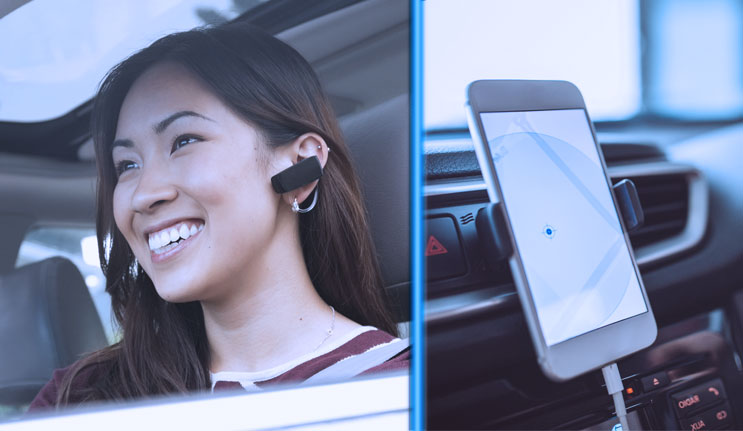By now, every driver should know that driving with a cell phone or other hand-held device is an accident waiting to happen. Technology companies have responded by introducing hands-free devices that allow drivers to keep their hands on the wheel while talking on their cell phones. But, are these hands-free devices really safer? The answer depends on who you talk to.
A study by the Virginia Tech Transportation Institute suggests that hands-free might be safer than using a handheld device while driving. But safety experts maintain that driving with a hands-free device is still distracted driving—and distracted driving kills people. According to the National Safety Council:
- More than 100 people die in vehicle crashes every day in the U.S as a result of distracted driving.
- Of those, nine people are killed due to accidents involving distracted drivers.
- Every day 1,000 people are injured due to distracted-driving accidents.
Perhaps most alarming, a study conducted by the National Highway Traffic Safety Administration (NHSTA), revealed that texting and driving is six times more dangerous than drunk driving.
What Is Distracted Driving?
Distracted driving is engaging in any activity that takes your attention and focus away from driving. It can be visual—taking your eyes off the road. It can be manual—taking your hands off the steering wheel. It can also be cognitive—letting your mind focus on something else besides your driving. Distracted driving can involve any one of these or a combination of two or all three.
Staying safe behind the wheel requires keeping your eyes on the road, your hands on the wheel, and your mind on driving. The average time a distracted driver’s eyes are off the road is only five seconds. But it only takes a few seconds of distracted driving to cause a crash. The faster you’re driving, the greater the odds of causing an accident. A car speeding down the road at 55 mph can travel 300 yards—the length of an entire football field—in just five seconds.
Hands-Free Gadgets
There are many gadgets designed to enable drivers to respond to text and email messages without handling their wireless devices. Most of them employ voice-to-text technology, so drivers can reply out loud and the app will convert the speech into text and send the message. Examples include:
Apple CarPlay. Plugging iPhones into this infotainment system enables drivers to make calls, send and receive text messages, and much more without touching their phone. Most of CarPlay’s features can be accessed via verbal commands to Siri, Apple’s digital assistant. For those that can’t, drivers must use their hands to select features on the touch-screen display in the dashboard. CarPlay doesn’t read emails out loud or allow the driver to respond to them.
Android Auto. Connecting your Android smartphone to this system and pressing the button on the steering wheel will activate Google Assistant. This will provide access to all your contacts, messages, music, maps, and other info without needing to touch your phone. As with CarPlay, you can hear and reply to text messages.
Other Hands-Free Gadgets
Other types of hands-free gadgets perform specific tasks so drivers can stay focused on their driving. Examples include:
- Bluetooth Headset. Worn over the ear, this gadget easily connects to your phone’s Bluetooth and improves incoming and outgoing sound quality.
- Sun Visor Bluetooth Speaker Clip. This small speaker clips to the driver-side sun visor for taking calls while driving. Connecting it to your phone activates the built-in motion sensor to automatically turn on the speaker.
- Universal Wireless FM Transmitter with Hands-Free Function. This handy gadget uses FM transmission technology to send voice calls or music from your mobile device to your car stereo.
- Steering Wheel Bluetooth Hands-Free Car Kit. This kit mounts on the steering wheel or dashboard and allow drivers to answer, end or reject a call. It also lets drivers play cell phone music without touching their phone.
Hands-Free Is Not the Solution
So, are hands-free devices safe? Or, do they still create a distraction for drivers?
The Virginia Tech study suggests that drivers who use hands-free electronic devices are less likely to get into a crash than those who use handheld devices. Their researchers found that the “primarily cognitive secondary task of talking on a hands-free device does not appear to have any detrimental effects.”
Many transportation and safety officials disagree. They maintain that driving safely requires three things: keeping your eyes on the road, your hands on the wheel, and your mind on driving. The problem with most “hands-free” devices is they don’t cover all three. At some point, most require the driver to engage in some action, such as pushing a button or looking at a display, which requires them to violate one of these tenets of safe driving.
Keep Your Fleet Drivers Safe on the Road with These eLearning Courses on Distracted Driving:
Furthermore, some studies have shown voice-to-text driving to be just as dangerous as texting and driving. When speaking a message, the mind can’t focus on driving as much as it should. As a result, the driver’s ability and judgement can be impaired. Therefore, voice-to-text technology does not resolve the issue of distraction. In fact, multitasking is a myth. The National Safety Council says drivers carrying a conversation on a cellphone can overlook up to 50% of what’s occurring around while looking out the windshield. Even more revealing—activity in the region of the brain that processes moving things is reduced by up to a third when talking or listening to the phone while driving. The real hidden danger is cognitive distraction.
Driving is a complex activity that requires our full attention. No text or email—whether sending or receiving—is worth your life or the lives of others. Do yourself and other drivers on the road a favor by putting away the mobile distractions until you reach your destination.
Resources:
https://www.nsc.org/road-safety/tools-resources/infographics/hands-free-is-not-risk-free
https://www.cdc.gov/motorvehiclesafety/distracted_driving/index.html
About the Author

Jonathan Herrera is the Marketing Manager for Fix Auto USA, a national network of locally-owned and operated auto body shops with a mission of delivering a world class collision repair experience across the U.S.
Keep your employees safe at work with these training courses on fleet safety:
Speeding Awareness – Large Vehicles



